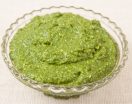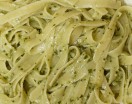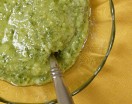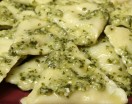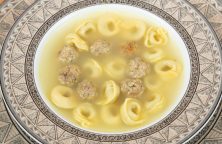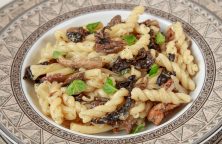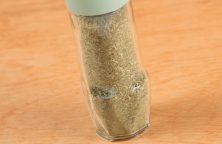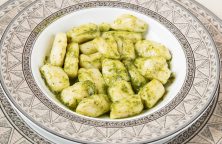Basil Pesto
2013-05-12- Cuisine: Italian, Mediterranean
- Course: Pasta & Rice, Soup
- Skill Level: Easy
- Yield : About 1 cup
- Servings : 8
- Prep Time : 20m
- Ready In : 20m
Related Recipes:
Nutritional Info
This information is per serving.
-
Calories
100 -
Calories from Fat
85 -
Total Fat
8.5g -
Saturated Fat
2g -
Trans Fat
0g -
Cholesterol
5mg -
Sodium
15mg -
Carbohydrates
1g -
Dietary Fiber
0g -
Sugar
0g -
Protein
1g -
Serving Size:
2 tbsps. (30 ml)
Most Americans associate Basil Pesto with pasta or pizza. Pesto is a basil based sauce originating in Genoa, Italy.
Like tomato and Alfredo sauce, pesto and can be used in a variety of ways to flavor soups or stews, spread on toasted bread, add a rich basil flavor to grilled chicken and fish and much more.
Pesto is high in olive oil and has more calories per tablespoon (15 ml) than Alfredo sauce. But, a little pesto goes a long way. One serving of tomato sauce is 1/2 cup (120 ml). A serving of Alfredo sauce 1/4 cup (60 ml). You can flavor one cup (150 g) of cooked paste with as little as 1 tablespoon (15 ml) of pesto. This is very low calorie considering 1/2 cup (120 ml) of Alfredo sauce has about 500 calories.
How much pesto you use in your recipes depends on how much you like the flavor of basil. Basil has a very intense flavor like rosemary. Some people find the basil’s flavor overpowering. If that is the case, you can reduce the intensity by substituting parsley, spinach or other leafy green for some of the basil.
Storing Pesto
Cut basil leaves oxidizes quickly when exposed to air. You can reduce the oxidation by covering your pesto with a thin layer of olive oil when refrigerated.
You can freeze pesto for long term storage. No extra oil is needed when freezing pesto. Divide the pesto into convenient serving sizes by using small containers, freezer bags, or ice cube trays.
Thaw frozen pesto in the refrigerator. Do not thaw pesto in a microwave oven. Basil oxidizes and darkens when exposed to high heat.
Sodium
Unlike many prepared pasta sauces, homemade pesto with no added salt is very low in sodium when made with good quality parmesan cheese like Parmigiano-Reggiano. Most tomato and cream sauces have between 200 and 450 mg of sodium per 1/2 cup serving compared to 15 mg for a 2 tbsp. (30 ml) serving of this pesto recipe made with Parmigiano-Reggiano.
Cook’s Tips
Substitute Italian parsley, spinach or kale for part of the basil if you find the flavor too intense.
For a milder garlic flavor, substitute toasted garlic.
Nutrition Information
Nutrition information is approximate and based on using 4 tablespoons (60 ml) of olive oil. Over 90 percent of pesto’s calories is from the oil and cheese.
Ingredients
- 2 cups (90 g) firmly packed fresh basil leaves
- 2 tablespoons (30 ml) pine nuts (optional)
- 3 to 4 garlic cloves
- 4 tablespoons (60 ml) extra virgin olive oil
- 1/4 cup (20 g) grated parmesan cheese (preferably Parmigiano-Reggiano)
- Black pepper to taste (optional)
Method of Preparation
Step 1
Toast pine nuts in a small skillet over medium low heat 3 to 4 minutes, stirring often, until golden brown.
Step 2
If desired, toast garlic in a small skillet over medium low heat 7 to 9 minutes turning occasionally until skin browns and cloves soften. Cool 1 to 2 minutes, remove the skin and coarsely chop.
Step 3
If desired, place basil in a plastic bad and bruise using a meat tenderizer, rolling pin or hammer to release the aromatic oil.
Step 4
In a food processor fitted with the metal blade or in a blender combine the basil and garlic and pulse until finely chopped. Scrap down the sides of the container if necessary.
Step 5
With the motor running add the oil in a steady stream until desired consistency. Alternatively, add half the oil, process, and then add more oil until you achieve the desired consistency. Pesto can be thick or thin depending on your preference. Each additional tablespoon of oil adds about 15 calories per serving.
Step 6
Add the cheese and pulse to combined. Season with pepper to taste. Add oil if necessary. Add the pine nuts and pulse to coarsely chop scraping the sides of the container if necessary.
Step 7
Use immediately or place in a container and cover with layer of oil to reduce oxidation, cover tightly and refrigerate up to 4 days.



